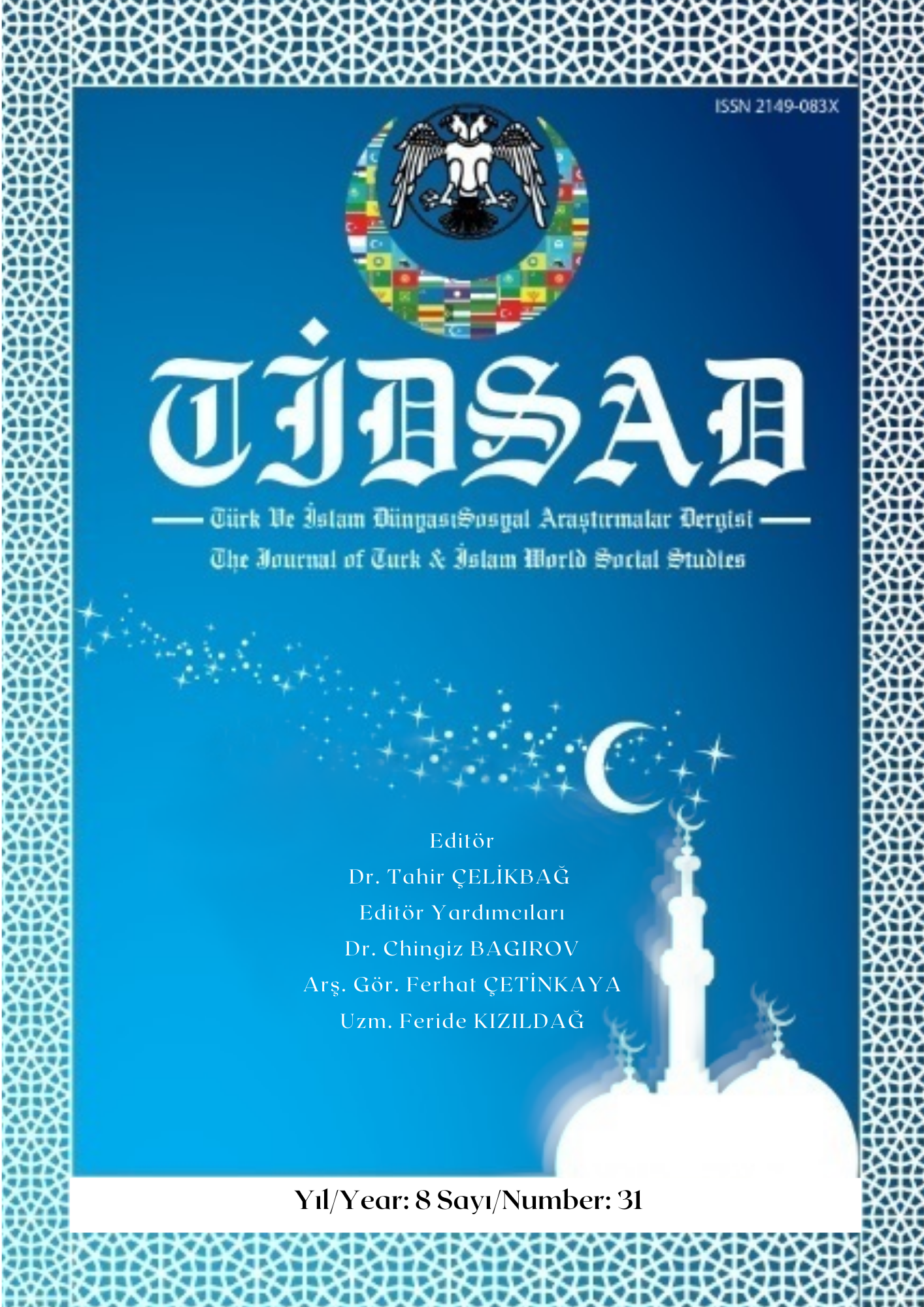Author :
Abstract
Hârezmşah Alâeddin Muhammed, İslam dünyasının baş etmekte zorlandığı kâfir Karahıtaylar’ı ağır bir şekilde mağlup etmiş (Ilâmış Zaferi 1210) ve Türk-İslâm dünyasındaki itibarını arttırmıştır. Horasan, Irak-ı Acem, Gazne ve Mâverâünnehir bölgelerini devletine bağlayan Hârezmşah, devletinin sınırlarını iki katına çıkarmış ve gittikçe güçlenen Türk-İslam devletini temsil ettiği için Abbâsî Halifesi Nâsır-Lidînillâh’dan kendisine “Sultanü’l-İslâm” unvanını vermesini istemiştir. Halife’nin bu isteği reddetmesi üzerine Hârezmşah Muhammed ile Halife arasında uzun süren bir savaş başlamıştır. Hârezmşah Muhammed, Halife Nâsır-Li-Dînillâh’ın hilafeti boyunca “Sultanü’l-İslâm” olma amacının gerçekleşmeyeceğini anlamış ve daha önce de halifenin Hârezmşah Devleti’ni yok etmek için Gur Devleti’ni savaşa teşvik etmesini de göz önünde bulundurarak Abbâsî halifesinin manevî gücünü kırmak için fikrî bir mücadele başlatmıştır. Hârezmşah, Abbasoğulları’nın halifelik makamını gasp yoluyla ele geçirdiğine dair fetva almış ve Halife’nin adını ülkesinin her yerinde okunan hutbelerden çıkarmıştır. Abbâsî Halifeliği ile başlayan fikrî mücadele, fizikî mücadeleye dönüşmüş ve Hârezmşah Muhammed, Bağdat üzerine büyük bir ordu göndermiş, Abbâsî Halifesi elçiler aracılığıyla bu mücadeleyi durdurmaya çalışmış fakat başarılı olamamıştır. Hârezm ordusunda ise Esedâbâd Dağları’nda yaşanan yoğun kar fırtınası nedeniyle birçok asker donarak ölmüştür. Halife Nâsır Hârezmşah Devleti ile baş edemediği için bu coğrafyada yeni bir güç olarak beliren Moğol Devleti’ni Hârezmşah Devleti üzerine sefere çıkmaya teşvik etmiştir. Fakat Moğol Devleti’nin lideri Cengiz Han, ilk aşamada Hârezmşah Devleti ile savaşmak yerine ticarî ilişkilerini geliştirmeyi tercih etmiştir.
Keywords
Abstract
Khwarazm Shah Alâeddin Muhammed heavily defeated (Ilâmış Victory 1210) the infidel Karahıtays, whom the Islamic world had difficulty in dealing with and increased his prestige in the Turkish-Islamic world. By connecting Khorasan, Iraq-i Acem, Ghazni and Transoxiana regions to his state, he doubled the borders of his state and asked the Abbasid Caliph Nasır-Lidînillâh to give him the title of "Sultanü'l-Islam" because he represented the increasingly stronger Turkish-Islamic state. Upon the caliph's refusal of this request, a long war began between Khwarezmshah Muhammad and the caliph. Khwarezmshah Muhammad understood that the purpose of becoming "Sultanu'l-Islam" would not be realized during the caliphate of Caliph Nasir-Li-Dînillâh, and the Abbasid caliph's spiritual started an intellectual struggle to break his power considering that the caliph encouraged the Gur State to war in order to destroy the Khwarazmshah State. Hârezmşah received a fatwa that the Abbasids had seized the caliphate by usurpation and derived the name of the Caliph from the sermons read all over her country. The intellectual struggle that started with the Abbasid Caliphate turned into a physical struggle, and Khwarazm Shah Mohammed sent a large army to Baghdad, and the Abbasid Caliph tried to stop this struggle through envoys, but was unsuccessful. In the Khwarazm army, many soldiers froze to death due to the heavy snowstorm in the Esedabad Mountains. Since the caliph Nasir could not cope with the Khwarazmshah State, he encouraged the Mongolian State, which emerged as a new power in this geography, to go on a campaign against the Khwarazmshah State. However, Genghis Khan, the leader of the Mongolian State, preferred to develop commercial relations instead of fighting with the Khwarazm Shah State in the first stage.
Keywords
- Alâeddin Ata Melik Cüveynî. (1999). Tarih-i Cihan Güşa (Çev.: Mürsel Öztürk). Ankara: Kül- tür Bakanlığı Yayınları.
- Barthold, V. V. (1990). Moğol İstilâsına Kadar Türkistan. Haz. Hakkı Dursun Yıldız. Ankara: TTK Yayınları.
- Bünyatov, Z. (2003). Hârezmşahlığı ve Enuştekinler Devleti (Çev.: Tural Rızayev). İstanbul: Derin Yayınları.
- Çakmak, M. A. (2007). Türk Sultan’ları ile Abbâsî Halifelerinin İktidar Mücadeleleri, (XII- XIII Yüzyıl). Türk Kültürü ve Hacı Bektaş Veli Araştırmaları Dergisi (44), 37-54.
- Çakmak, M. A., Hamarat, E. (2005). İnkişaftan İnhitata Bir Türk Sultanı Alâeddin Muhamed Hârezmşah (1200-1220). Hacettepe Üniversitesi Türkiyat Araştırmaları Dergisi (23), 125-148.
- D’ohsson, A. C. (2008). Moğol Tarihi (Çev.: Bahadır Apaydın). İstanbul: Nesnel Yayınları.
- Ebû Şâme, Şihabüddin Ebû Muhammed Abdurrahman bin İsmâil. 2002. Kitâbü Ravzateyn Fî Ahbâri Devleteyn En-Nûriyye ve’s-Selâhiyye. C. 5. (Thk. İbrahim Şemsüddin, Dâru’l-Kütübi’lİlmiyye. Beyrut.
- Gürbüz, O. (2011). Abbâsî Halifesi Nâsır-Lidînillâh’ın Hârezmşahlar ile İktidar Mücadelesi. İstem Dergisi (18), 181-196.
- Güzel, F. (2015). Moğol İstilasında Halife Nâsır li-Dinillâ’ın Rolü. İnsan ve Toplum Bilimleri Araştırmaları Dergisi 4 (1), 142-158
- İbn Kesîr. (2000). El-Bidâye ve’n-Nihâye (Büyük İslâm Tarihi). C. 13. Çev. Mehmed Keskin. İstanbul: Çağrı Yayınları.
- İbnü’l-Esîr. (1987). İslâm Tarihi el Kâmil Fi’t-Tarih, C. 12 (Çev.: Ahmed Ağırakça - Abdülke- rim Özaydın). İstanbul: Türkiyat Matbaacılık.
- Kafesoğlu, İ. (1992). Harezmşahlar Devleti Tarihi. Ankara: TTK Yayınları.
- Köprülü, M. F. (1991). Türk Edebiyatında İlk Mutasavvıflar. Ankara: Diyanet İşleri Bakanlığı Yayınları.
- Lamb, H. (1985). Cengiz Han (Çev.: Ali Ünal). İstanbul: İhya Yayınları.
- Özdemir, A. (2005). Moğol İstilâsı, Cengiz ve Hülâgû Dönemleri. İstanbul: İz Yayıncılık.
- Spuler, B. (1957). İran Moğolları Siyaset idare ve Kültür İlhanlılar Devri. 1220-1350 (Çev.: Cemal Köprülü). Ankara: TTK Yayınları.





